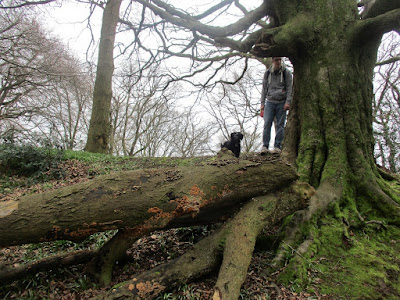 Caerleon is famed for its Roman remains. I hadn't been there since I was at school. We had quite a walk ahead of us, though, so we made do with a flying visit to the amphitheatre ...
Caerleon is famed for its Roman remains. I hadn't been there since I was at school. We had quite a walk ahead of us, though, so we made do with a flying visit to the amphitheatre ...... which was built to serve the nearby Roman legionary fortress of Isca Augusta (or Isca Silorum) in around 90AD. Interestingly, it was known in the Middle Ages as King Arthur's Round Table.
We were headed for a different fort, however - the iron age hill fort that tops the wooded ridge overlooking the village.
This involved a long and slightly tedious drag uphill ...
... although there was some poetry - a passing glimpse of the Hanbury Arms, down by the River Usk, where Tennyson worked on his Idylls of the King, which is about King Arthur. (Are you sensing a theme?) ...
... and this sign in the window of a local primary school.
Then we were off tarmac and onto a muddy track and things started getting interesting.
 Lodge Wood hill fort was constructed some 300 to 500 years before the arrival of the Romans.
Lodge Wood hill fort was constructed some 300 to 500 years before the arrival of the Romans. The Silures - a fierce tribe, apparently - fought back against the Roman occupation, but were eventually either beaten or persuaded to work with them.
When the Romans left in 400AD, many hillforts were reoccupied. During this period, King Arthur is said to have led the fightback against the Saxon invasion. In the 12th century, Geoffrey of Monmouth claims Caerleon is the site of Camelot.
We didn't see the ghosts of any Roman centurions or courtly knights, but there was a funny feeling about the woods. As if the Pwca might live there.
The place will be full of bluebells shortly.
In the meantime, we got to admire the beautifully delicate and quite widespread wood anemones.
The woods thinned as we left the area of the fort and views over Newport and the looping River Usk opened up.
I kept Ted well away from this pond.
We picked our way down a very slippery hillside to the road by Pwll-Mawr Farm.
However, the ground was so already so wet and treacherous that we decided to return to town on the new boardwalk alongside the river.
 Still, you know you've had a good walk when your boots look like this.
Still, you know you've had a good walk when your boots look like this. 

















Wonderful!
ReplyDelete